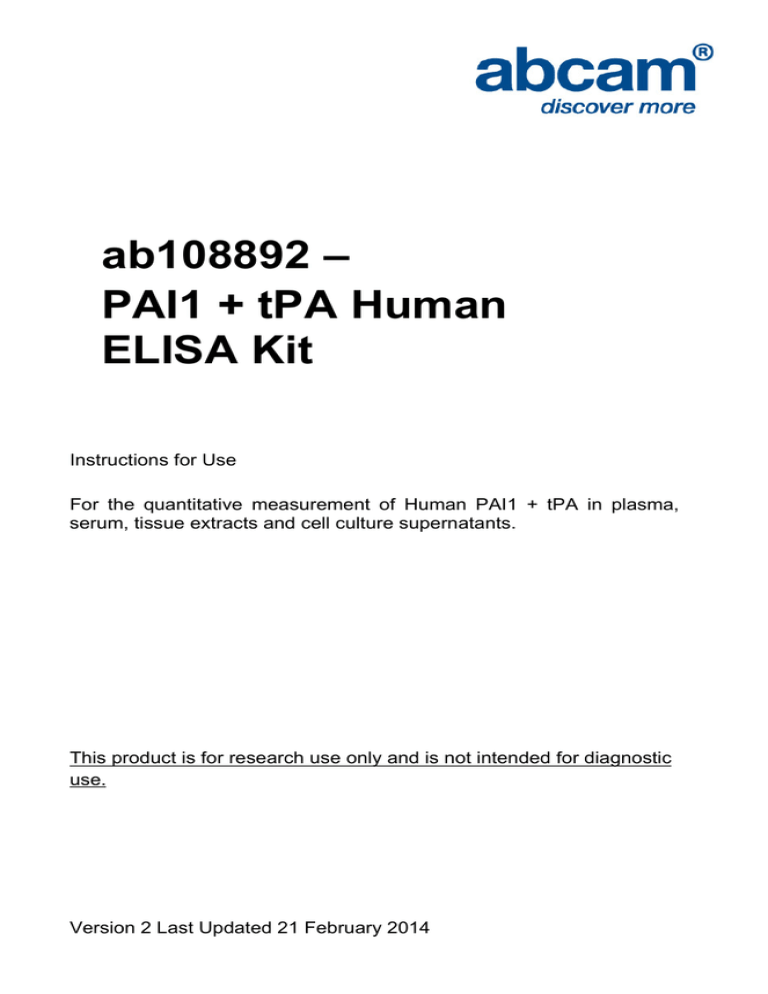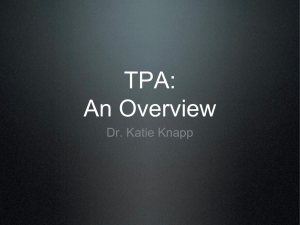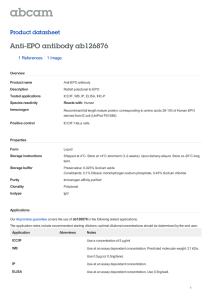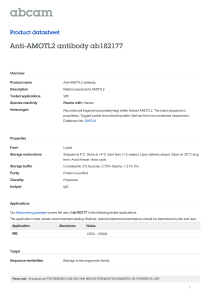
ab108892 –
PAI1 + tPA Human
ELISA Kit
Instructions for Use
For the quantitative measurement of Human PAI1 + tPA in plasma,
serum, tissue extracts and cell culture supernatants.
This product is for research use only and is not intended for diagnostic
use.
Version 2 Last Updated 21 February 2014
Table of Contents
INTRODUCTION
1.
BACKGROUND
2
2.
ASSAY SUMMARY
3
GENERAL INFORMATION
3.
PRECAUTIONS
4
4.
STORAGE AND STABILITY
4
5.
MATERIALS SUPPLIED
4
6.
MATERIALS REQUIRED, NOT SUPPLIED
5
7.
LIMITATIONS
5
8.
TECHNICAL HINTS
6
ASSAY PREPARATION
9.
REAGENT PREPARATION
10.
STANDARD PREPARATIONS
10
7
11.
SAMPLE PREPARATION
13
12.
PLATE PREPARATION
14
ASSAY PROCEDURE
13.
ASSAY PROCEDURE
15
DATA ANALYSIS
14.
CALCULATIONS
17
15.
TYPICAL DATA
18
16.
TYPICAL SAMPLE VALUES
19
17.
ASSAY SPECIFICITY
20
RESOURCES
18.
TROUBLESHOOTING
21
19.
NOTES
23
Discover more at www.abcam.com
1
INTRODUCTION
1. BACKGROUND
Abcam’s PAI1 + tPA Human in vitro ELISA (Enzyme-Linked
Immunosorbent Assay) kit is designed for the quantitative
measurement of PAI1 + tPA concentrations in plasma, serum, tissue
extracts and cell culture supernatants.
A PAI1 + tPA specific antibody has been precoated onto 96-well plates
and blocked. Standards or test samples are added to the wells and
subsequently a PAI1 + tPA specific biotinylated detection antibody is
added and then followed by washing with wash buffer. StreptavidinPeroxidase Conjugate is added and unbound conjugates are washed
away with wash buffer. TMB is then used to visualize StreptavidinPeroxidase enzymatic reaction. TMB is catalyzed by StreptavidinPeroxidase to produce a blue color product that changes into yellow
after adding acidic stop solution. The density of yellow coloration is
directly proportional to the amount of PAI1 + tPA captured in plate.
Type I Plasminogen activator inhibitor (PAI1) is a 50 kDa serpin family
member that inhibits tissue- and urokinase-type Plasminogen
activators (t-PA, u-PA). Whereas tPA is a 68 kDa serine protease that
converts the Plasminogen into plasmin and facilitates the digestion of
fibrin clots. In plasma, half or more of PAI1 and most tPA present in the
circulation is in an inhibited complex. In the resting state in healthy
individuals, typically less than 20% of tPA is present in its free form in
the plasma. In normal individuals, as well as in patients with recurrent
venous thrombosis, high PAI1 plasma concentration is usually
associated with high tPA antigen (but not with free tPA) levels.
PAI1/tPA complex, a novel fibrinolytic marker, increases during the
pregnancy-associated hypercoagulable state, atherosclerosis, and
vascular spasm. Determination of PAI1/tPA complex may provide
valuable prognostic information with respect to breast cancer patients
and myocardial infarction in patients with manifest coronary heart
disease.
Discover more at www.abcam.com
2
INTRODUCTION
2. ASSAY SUMMARY
Prepare all reagents, samples and
standards as instructed.
Add standard or sample to each well
used. Incubate at room temperature.
Wash and add prepared biotin
antibody to each well. Incubate at
room temperature.
Wash and add prepared StreptavidinPeroxidase Conjugate. Incubate at
room temperature.
Add Chromogen Substrate to each
well. Incubate at room temperature.
Add Stop Solution to each well. Read
immediately.
Discover more at www.abcam.com
3
GENERAL INFORMATION
3. PRECAUTIONS
Please read these instructions carefully prior to beginning the
assay.
Modifications to the kit components or procedures may result in loss of
performance.
4. STORAGE AND STABILITY
Store kit at 4°C immediately upon receipt, apart from the
SP Conjugate & Biotinylated Antibody, which should be stored at
-20°C.
Refer to list of materials supplied for storage conditions of individual
components. Observe the storage conditions for individual prepared
components in sections 9 & 10.
5. MATERIALS SUPPLIED
96 wells
Storage
Condition
(Before
Preparation)
4°C
PAI1 + tPA Standard
1 vial
4°C
10X Diluent M Concentrate
30 mL
4°C
Biotinylated Human PAI1 + tPA Antibody
100X Streptavidin-Peroxidase Conjugate
(SP Conjugate)
Chromogen Substrate
1 vial
-20°C
80 µL
-20°C
8 mL
4°C
Stop Solution
12 mL
4°C
2 x 30 mL
4°C
3
N/A
Item
PAI1 + tPA Microplate (12 x 8 well strips)
20X Wash Buffer Concentrate
Sealing Tapes
Discover more at www.abcam.com
Amount
4
GENERAL INFORMATION
6. MATERIALS REQUIRED, NOT SUPPLIED
These materials are not included in the kit, but will be required to
successfully utilize this assay:
1 Microplate reader capable of measuring absorbance at 450 nm.
Precision pipettes to deliver 1 µL to 1 mL volumes.
Adjustable 1-25 mL pipettes for reagent preparation.
100 mL and 1 liter graduated cylinders.
Absorbent paper.
Distilled or deionized water.
Log-log graph paper or computer and software for ELISA data
analysis.
8 tubes to prepare standard or sample dilutions.
7. LIMITATIONS
Do not mix or substitute reagents or materials from other kit lots or
vendors.
Discover more at www.abcam.com
5
GENERAL INFORMATION
8. TECHNICAL HINTS
Samples generating values higher than the highest standard
should be further diluted in the appropriate sample dilution buffers.
Avoid foaming
components.
Avoid cross contamination of samples or reagents by changing tips
between sample, standard and reagent additions.
Ensure plates are properly sealed or covered during incubation
steps.
Complete removal of all solutions and buffers during wash steps.
This kit is sold based on number of tests. A ‘test’ simply
refers to a single assay well. The number of wells that contain
sample, control or standard will vary by product. Review the
protocol completely to confirm this kit meets your
requirements. Please contact our Technical Support staff with
any questions.
or
bubbles
Discover more at www.abcam.com
when
mixing
or
reconstituting
6
ASSAY PREPARATION
9. REAGENT PREPARATION
Equilibrate all reagents to room temperature (18-25°C) prior to use.
Prepare fresh reagents immediately prior to use. If crystals have
formed in the concentrate, mix gently until the crystals have completely
dissolved.
9.1
1X Diluent M
Dilute the 10X Diluent M Concentrate 1:10 with reagent
grade water. Mix gently and thoroughly. Store for up to
1 month at 4°C.
9.2
1X Wash Buffer
Dilute the 20X Wash Buffer Concentrate 1:20 with reagent
grade water. Mix gently and thoroughly.
9.3
1X Biotinylated PAI1 + tPA Detector Antibody
9.3.1
The stock Biotinylated PAI1 + tPA Antibody must be
diluted with 1X Diluent M according to the label
concentration to prepare 1X Biotinylated PAI1 + tPA
Antibody for use in the assay procedure. Observe
the label for the “X” concentration on the vial of
Biotinylated PAI1 + tPA Antibody.
9.3.2
Calculate the necessary amount of 1X Diluent M to
dilute the Biotinylated PAI1 + tPA Antibody to
prepare a 1X Biotinylated PAI1 + tPA Antibody
solution for use in the assay procedure according to
how many wells you wish to use and the following
calculation:
Number of
Wells Strips
Number of
Wells
4
6
8
10
12
32
48
64
80
96
(VT) Total Volume of 1X Biotinylated
Antibody (µL)
1,760
2,640
3,520
4,400
5,280
Any remaining solution should be frozen at -20°C.
Discover more at www.abcam.com
7
ASSAY PREPARATION
Where:
CS = Starting concentration (X) of stock Biotinylated PAI1 + tPA
Antibody (variable)
CF = Final concentration (always = 1X) of 1X Biotinylated PAI1 + tPA
Antibody solution for the assay procedure
VT = Total required volume of 1X Biotinylated PAI1 + tPA Antibody
solution for the assay procedure
VA = Total volume of (X) stock Biotinylated PAI1 + tPA Antibody
VD = Total volume of 1X Diluent M required to dilute (X) stock
Biotinylated PAI1 + tPA Antibody to prepare 1X Biotinylated
PAI1 + tPA solution for assay procedures
Calculate the volume of (X) stock Biotinylated Antibody required for the
given number of desired wells:
(CF / CS) x VT = VA
Calculate the final volume of 1X Diluent M required to prepare the
1X Biotinylated PAI1 + tPA Antibody:
VT - V A = V D
Example:
NOTE: This example is for demonstration purposes only. Please
remember to check your antibody vial for the actual concentration
of antibody provided.
CS = 50X Biotinylated PAI1 + tPA Antibody stock
CF = 1X Biotinylated PAI1 + tPA Antibody solution for use in the assay
procedure
VT = 3,520 µL (8 well strips or 64 wells)
(1X/50X) x 3,520 µL = 70.4 µL
3,520 µL - 70.4 µL = 3,449.6 µL
VA = 70.4 µL total volume of (X) stock Biotinylated PAI1 + tPA Antibody
required
VD = 3,449.6 µL total volume of 1X Diluent M required to dilute the
50X stock Biotinylated Antibody to prepare 1X Biotinylated PAI1 +
tPA Antibody solution for assay procedures
Discover more at www.abcam.com
8
ASSAY PREPARATION
9.4
9.3.3
First spin the Biotinylated PAI1 + tPA Antibody vial
to collect the contents at the bottom.
9.3.4
Add calculated amount VA of stock Biotinylated
PAI1 + tPA Antibody to the calculated amount VD of
1X Diluent M. Mix gently and thoroughly.
1X SP Conjugate
Spin down the 100X Streptavidin-Peroxidase Conjugate
(SP Conjugate) briefly and dilute the desired amount of the
conjugate 1:100 with 1X Diluent M.
Any remaining solution should be frozen at -20°C.
Discover more at www.abcam.com
9
ASSAY PREPARATION
10. STANDARD PREPARATIONS
Prepare serially diluted standards immediately prior to use.
Always prepare a fresh set of standards for every use.
Any remaining standard should be stored at -20°C after
reconstitution and used within 30 days.
This procedure prepares sufficient standard dilutions for
duplicate wells.
10.1
Reconstitution of the PAI1 + tPA Standard vial to prepare a
4 ng/mL PAI1 + tPA Standard #1
10.1.1
First consult the PAI1 + tPA Standard vial to
determine the mass of protein in the vial.
10.1.2
Calculate the appropriate volume of 1X Diluent M
to add when resuspending the PAI1 + tPA
Standard vial to produce a 4 ng/mL PAI1 + tPA
Standard #1 by using the following equation:
CS = Starting mass of PAI1 + tPA Standard (see vial label) (ng)
CF = 4 ng/mL PAI1 + tPA Standard #1 final required
concentration
VD = Required volume of 1X Diluent M for reconstitution (µL)
Calculate total required volume 1X Diluent M for resuspension:
(CS /CF) x 1,000 = VD
Example:
NOTE: This example is for demonstration purposes only.
Please remember to check your standard vial for the actual
amount of standard provided.
CS = 8 ng of PAI1 + tPA Standard in vial
CF = 4 ng/mL PAI1 + tPA Standard #1 final concentration
VD = Required volume of 1X Diluent M for reconstitution
(8 ng / 4 ng/mL) x 1,000 = 2,000 µL
Discover more at www.abcam.com
10
ASSAY PREPARATION
10.1.3
First briefly spin the PAI1 + tPA Standard Vial to
collect the contents on the bottom of the tube.
10.1.4
Reconstitute the PAI1 + tPA Standard vial by
adding the appropriate calculated amount VD of
1X Diluent M to the vial to generate the 4 ng/mL
PAI1 + tPA Standard #1. Mix gently and
thoroughly.
10.2
Allow the reconstituted 4 ng/mL PAI1 + tPA Standard #1 to
sit for 10 minutes with gentle agitation prior to making
subsequent dilutions.
10.3
Label seven tubes #2 – 8.
10.4
Add 120 µL of 1X Diluent M to tubes #2 – 8.
10.5
To prepare Standard #2, add 120 μL of the Standard #1
into tube #2 and mix gently.
10.6
To prepare Standard #3, add 120 μL of the Standard #2
into tube #3 and mix gently.
10.7
Using the table below as a guide, prepare subsequent
serial dilutions.
10.8
1X Diluent M serves as the zero standard, 0 ng/mL
(tube #8).
Discover more at www.abcam.com
11
ASSAY PREPARATION
Standard Dilution Preparation Table
Standard
#
1
2
3
4
5
6
7
8
Volume
to
Dilute
(µL)
120
120
120
120
120
120
-
Volume
Total
Diluent
Volume
M
(µL)
(µL)
Step 10.1
120
240
120
240
120
240
120
240
120
240
120
240
120
120
Discover more at www.abcam.com
Starting
Conc.
(ng/mL)
4.000
2.000
1.000
0.500
0.250
0.125
-
Final Conc.
(ng/mL)
4.000
2.000
1.000
0.500
0.250
0.125
0.063
0
12
ASSAY PREPARATION
11. SAMPLE PREPARATION
11.1 Plasma
Collect plasma using one-tenth volume of 0.1 M sodium
citrate as an anticoagulant. Centrifuge samples at 3,000 x g
for 10 minutes. Dilute samples 1:4 with 1X Diluent M and
assay. The undiluted samples can be stored at -20°C or
below for up to 3 months. Avoid repeated freeze-thaw cycles
(EDTA or Heparin can also be used as an anticoagulant).
11.2 Serum
Samples should be collected into a serum separator tube.
After clot formation, centrifuge samples at 3,000 x g for
10 minutes. Dilute samples 1:4 with 1X Diluent M and assay.
The undiluted samples can be stored at -20°C or below for
up to 3 months. Avoid repeated freeze-thaw cycles.
11.3 Cell Culture Supernatants
Centrifuge cell culture media at 3,000 x g for 10 minutes to
remove debris. Collect supernatants and assay. Store
samples at -20°C or below. Avoid repeated freeze-thaw
cycles.
11.4 Tissue
Extract tissue samples with 100 mM phosphate-buffered
saline (pH7.4) containing 1% Triton X-100 and centrifuge at
14,000 x g for 20 minutes. Collect the supernatant and
measure the protein concentration. Dilute the tissue extract if
necessary and assay. Freeze the remaining extract at -20°C
or below.
Discover more at www.abcam.com
13
ASSAY PREPARATION
12. PLATE PREPARATION
The 96 well plate strips included with this kit are supplied ready to
use. It is not necessary to rinse the plate prior to adding reagents.
Unused well plate strips should be returned to the plate packet and
stored at 4°C.
For statistical reasons, we recommend each sample should be
assayed with a minimum of two replicates (duplicates).
Well effects have not been observed with this assay. Contents of
each well can be recorded on the template sheet included in the
Resources section.
Discover more at www.abcam.com
14
ASSAY PROCEDURE
13. ASSAY PROCEDURE
●
Equilibrate all materials and prepared reagents to room
temperature (18 - 25°C) prior to use.
●
It is recommended to assay all standards, controls and
samples in duplicate.
13.1
Prepare all reagents, working standards and samples as
instructed. Equilibrate reagents to room temperature before
use. The assay is performed at room temperature
(18-25°C).
13.2
Remove excess microplate strips from the plate frame and
return them immediately to the foil pouch with desiccant
inside. Reseal the pouch securely to minimize exposure to
water vapor and store in a vacuum desiccator.
13.3
Add 50 μL of PAI1 + tPA standard or sample per well.
Cover wells with a sealing tape and incubate for two hours.
Start the timer after the last sample addition.
13.4
Wash five times with 200 μL of 1X Wash Buffer manually.
Invert the plate each time and decant the contents; tap it
4-5 times on absorbent paper towel to completely remove
the liquid. If using a machine wash six times with 300 μL of
1X Wash Buffer and then invert the plate, decant the
contents; tap it 4-5 times on absorbent paper towel to
completely remove the liquid.
13.5
Add 50 μL of 1X Biotinylated PAI1 + tPA Antibody to each
well and incubate for one hour.
13.6
Wash microplate as described above.
13.7
Add 50 μL of 1X SP Conjugate to each well and incubate
for 30 minutes. Turn on the microplate reader and set up
the program in advance.
13.8
Wash microplate as described above.
13.9
Add 50 μL of Chromogen Substrate per well and incubate
for about 15 minutes or till the optimal blue colour density
Discover more at www.abcam.com
15
ASSAY PROCEDURE
develops. Gently tap plate to ensure thorough mixing and
break the bubbles in the well with pipette tip.
13.10 Add 50 μL of Stop Solution to each well. The color will
change from blue to yellow.
13.11 Read the absorbance on a microplate reader at a
wavelength of 450 nm immediately. If wavelength correction
is available, subtract readings at 570 nm from those at
450 nm to correct optical imperfections. Otherwise, read the
plate at 450 nm only. Please note that some unstable black
particles may be generated at high concentration points
after stopping the reaction for about 10 minutes, which will
reduce the readings.
Discover more at www.abcam.com
16
DATA ANALYSIS
14. CALCULATIONS
Calculate the mean value of the triplicate readings for each standard
and sample. To generate a Standard Curve, plot the graph using the
standard concentrations on the x-axis and the corresponding mean
450 nm absorbance on the y-axis. The best-fit line can be determined
by regression analysis using log-log or four-parameter logistic curve-fit.
Determine the unknown sample concentration from the Standard
Curve and multiply the value by the dilution factor.
Discover more at www.abcam.com
17
DATA ANALYSIS
15. TYPICAL DATA
TYPICAL STANDARD CURVE – Data provided for demonstration
purposes only. A new standard curve must be generated for each
assay performed.
Discover more at www.abcam.com
18
DATA ANALYSIS
16. TYPICAL SAMPLE VALUES
SENSITIVITY –
The minimum detectable dose of PAI1 + tPA is typically ~0.06 ng/mL.
RECOVERY –
Standard Added Value: 0.125 – 2 ng/mL
Recovery %: 86 – 111.
Average Recovery %: 98
REFERENCE VALUES
Normal Human plasma PAI1/tPA concentration has been reported
ranging approximately from 2.4 to 8.8 ng/mL.
LINEARITY OF DILUTION –
Plasma Dilution
Average % Expected Value
1.2
1:4
1:8
87
98
110
Serum Dilution
Average % Expected Value
1:2
1:4
1:8
88
99
108
PRECISION –
% CV
IntraAssay
4.9
Discover more at www.abcam.com
InterAssay
7.2
19
DATA ANALYSIS
17. ASSAY SPECIFICITY
Species
% Cross Reactivity
Human
100
Monkey
<5
Mouse
None
Rat
None
Swine
<5
Rabbit
None
Canine
None
Bovine
None
Discover more at www.abcam.com
20
RESOURCES
18. TROUBLESHOOTING
Problem
Poor standard
curve
Cause
Improper standard
dilution
Standard improperly
reconstituted (if
applicable)
Standard degraded
Curve doesn't fit scale
Incubation time too short
Low signal
Target present below
detection limits of assay
Precipitate can form in
wells upon substrate
addition when
concentration of target is
too high
Using incompatible
sample type (e.g. serum
vs. cell extract)
Sample prepared
incorrectly
Bubbles in wells
All wells not washed
equally/thoroughly
Large CV
Solution
Confirm dilutions made
correctly
Briefly spin vial before
opening; thoroughly
resuspend powder (if
applicable)
Store sample as
recommended
Try plotting using different
scale
Try overnight incubation at
4oC
Decrease dilution factor;
concentrate samples
Increase dilution factor of
sample
Detection may be reduced
or absent in untested
sample types
Ensure proper sample
preparation/dilution
Ensure no bubbles present
prior to reading plate
Check that all ports of plate
washer are unobstructed
wash wells as
recommended
Incomplete reagent
mixing
Ensure all reagents/master
mixes are mixed thoroughly
Inconsistent pipetting
Use calibrated pipettes and
ensure accurate pipetting
Inconsistent sample
preparation or storage
Ensure consistent sample
preparation and optimal
sample storage conditions
(eg. minimize freeze/thaws
cycles)
Discover more at www.abcam.com
21
RESOURCES
Problem
High
background/
Low sensitivity
Cause
Solution
Wells are insufficiently
washed
Wash wells as per protocol
recommendations
Contaminated wash
buffer
Make fresh wash buffer
Waiting too long to read
plate after adding STOP
solution
Read plate immediately
after adding STOP solution
Improper storage of
ELISA kit
Store all reagents as
recommended. Please
note all reagents may not
have identical storage
requirements.
Using incompatible
sample type (e.g. Serum
vs. cell extract)
Detection may be reduced
or absent in untested
sample types
Discover more at www.abcam.com
22
RESOURCES
19. NOTES
Discover more at www.abcam.com
23
RESOURCES
Discover more at www.abcam.com
24
RESOURCES
Discover more at www.abcam.com
25
RESOURCES
Discover more at www.abcam.com
26
UK, EU and ROW
Email: technical@abcam.com | Tel: +44-(0)1223-696000
Austria
Email: wissenschaftlicherdienst@abcam.com | Tel: 019-288-259
France
Email: supportscientifique@abcam.com | Tel: 01-46-94-62-96
Germany
Email: wissenschaftlicherdienst@abcam.com | Tel: 030-896-779-154
Spain
Email: soportecientifico@abcam.com | Tel: 911-146-554
Switzerland
Email: technical@abcam.com
Tel (Deutsch): 0435-016-424 | Tel (Français): 0615-000-530
US and Latin America
Email: us.technical@abcam.com | Tel: 888-77-ABCAM (22226)
Canada
Email: ca.technical@abcam.com | Tel: 877-749-8807
China and Asia Pacific
Email: hk.technical@abcam.com | Tel: 108008523689 (中國聯通)
Japan
Email: technical@abcam.co.jp | Tel: +81-(0)3-6231-0940
www.abcam.com | www.abcam.cn | www.abcam.co.jp
Copyright © 2013 Abcam, All Rights Reserved. The Abcam logo is a registered trademark.
All information / detail is correct at time of going to print.
RESOURCES
27





